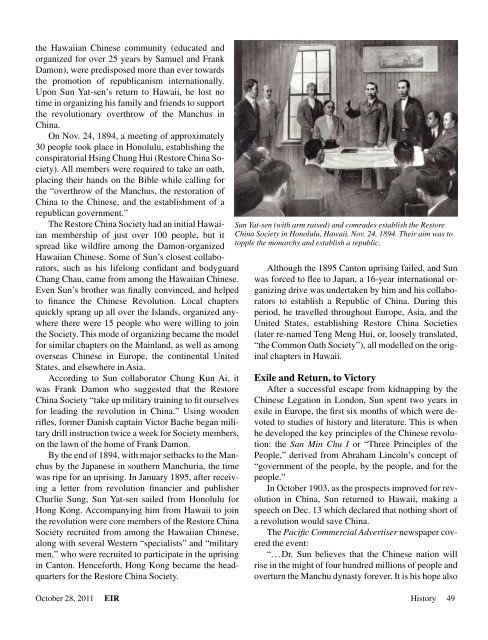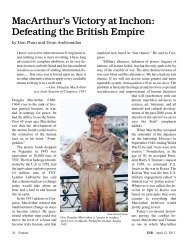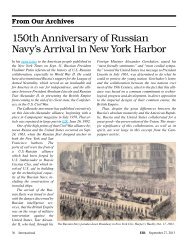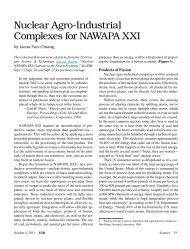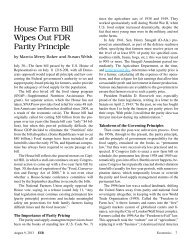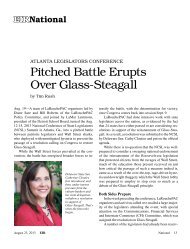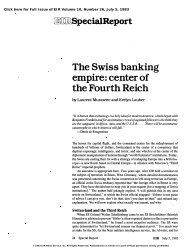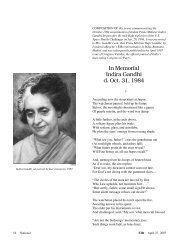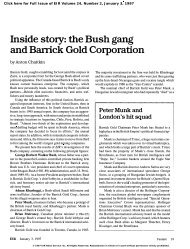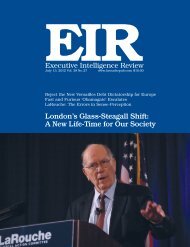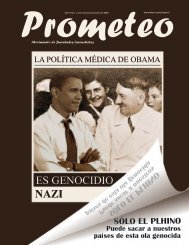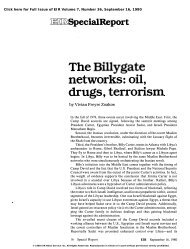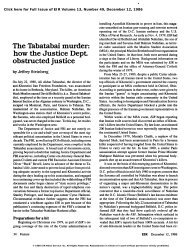Sun Yat-sen's Legacy and The American Revolution
Sun Yat-sen's Legacy and The American Revolution
Sun Yat-sen's Legacy and The American Revolution
Create successful ePaper yourself
Turn your PDF publications into a flip-book with our unique Google optimized e-Paper software.
the Hawaiian Chinese community (educated <strong>and</strong><br />
organized for over 25 years by Samuel <strong>and</strong> Frank<br />
Damon), were predisposed more than ever towards<br />
the promotion of republicanism internationally.<br />
Upon <strong>Sun</strong> <strong>Yat</strong>-sen’s return to Hawaii, he lost no<br />
time in organizing his family <strong>and</strong> friends to support<br />
the revolutionary overthrow of the Manchus in<br />
China.<br />
On Nov. 24, 1894, a meeting of approximately<br />
30 people took place in Honolulu, establishing the<br />
conspiratorial Hsing Chung Hui (Restore China Society).<br />
All members were required to take an oath,<br />
placing their h<strong>and</strong>s on the Bible while calling for<br />
the “overthrow of the Manchus, the restoration of<br />
China to the Chinese, <strong>and</strong> the establishment of a<br />
republican government.”<br />
<strong>The</strong> Restore China Society had an initial Hawaiian<br />
membership of just over 100 people, but it<br />
spread like wildfire among the Damon-organized<br />
Hawaiian Chinese. Some of <strong>Sun</strong>’s closest collaborators,<br />
such as his lifelong confidant <strong>and</strong> bodyguard<br />
Chang Chau, came from among the Hawaiian Chinese.<br />
Even <strong>Sun</strong>’s brother was finally convinced, <strong>and</strong> helped<br />
to finance the Chinese <strong>Revolution</strong>. Local chapters<br />
quickly sprang up all over the Isl<strong>and</strong>s, organized anywhere<br />
there were 15 people who were willing to join<br />
the Society. This mode of organizing became the model<br />
for similar chapters on the Mainl<strong>and</strong>, as well as among<br />
overseas Chinese in Europe, the continental United<br />
States, <strong>and</strong> elsewhere in Asia.<br />
According to <strong>Sun</strong> collaborator Chung Kun Ai, it<br />
was Frank Damon who suggested that the Restore<br />
China Society “take up military training to fit ourselves<br />
for leading the revolution in China.” Using wooden<br />
rifles, former Danish captain Victor Bache began military<br />
drill instruction twice a week for Society members,<br />
on the lawn of the home of Frank Damon.<br />
By the end of 1894, with major setbacks to the Manchus<br />
by the Japanese in southern Manchuria, the time<br />
was ripe for an uprising. In January 1895, after receiving<br />
a letter from revolution financier <strong>and</strong> publisher<br />
Charlie <strong>Sun</strong>g, <strong>Sun</strong> <strong>Yat</strong>-sen sailed from Honolulu for<br />
Hong Kong. Accompanying him from Hawaii to join<br />
the revolution were core members of the Restore China<br />
Society recruited from among the Hawaiian Chinese,<br />
along with several Western “specialists” <strong>and</strong> “military<br />
men,” who were recruited to participate in the uprising<br />
in Canton. Henceforth, Hong Kong became the headquarters<br />
for the Restore China Society.<br />
<strong>Sun</strong> <strong>Yat</strong>-sen (with arm raised) <strong>and</strong> comrades establish the Restore<br />
China Society in Honolulu, Hawaii, Nov. 24, 1894. <strong>The</strong>ir aim was to<br />
topple the monarchy <strong>and</strong> establish a republic.<br />
Although the 1895 Canton uprising failed, <strong>and</strong> <strong>Sun</strong><br />
was forced to flee to Japan, a 16-year international organizing<br />
drive was undertaken by him <strong>and</strong> his collaborators<br />
to establish a Republic of China. During this<br />
period, he travelled throughout Europe, Asia, <strong>and</strong> the<br />
United States, establishing Restore China Societies<br />
(later re-named Teng Meng Hui, or, loosely translated,<br />
“the Common Oath Society”), all modelled on the original<br />
chapters in Hawaii.<br />
Exile <strong>and</strong> Return, to Victory<br />
After a successful escape from kidnapping by the<br />
Chinese Legation in London, <strong>Sun</strong> spent two years in<br />
exile in Europe, the first six months of which were devoted<br />
to studies of history <strong>and</strong> literature. This is when<br />
he developed the key principles of the Chinese revolution:<br />
the San Min Chu I or “Three Principles of the<br />
People,” derived from Abraham Lincoln’s concept of<br />
“government of the people, by the people, <strong>and</strong> for the<br />
people.”<br />
In October 1903, as the prospects improved for revolution<br />
in China, <strong>Sun</strong> returned to Hawaii, making a<br />
speech on Dec. 13 which declared that nothing short of<br />
a revolution would save China.<br />
<strong>The</strong> Pacific Commercial Advertiser newspaper covered<br />
the event:<br />
“. . . Dr. <strong>Sun</strong> believes that the Chinese nation will<br />
rise in the might of four hundred millions of people <strong>and</strong><br />
overturn the Manchu dynasty forever. It is his hope also<br />
October 28, 2011 EIR History 49


